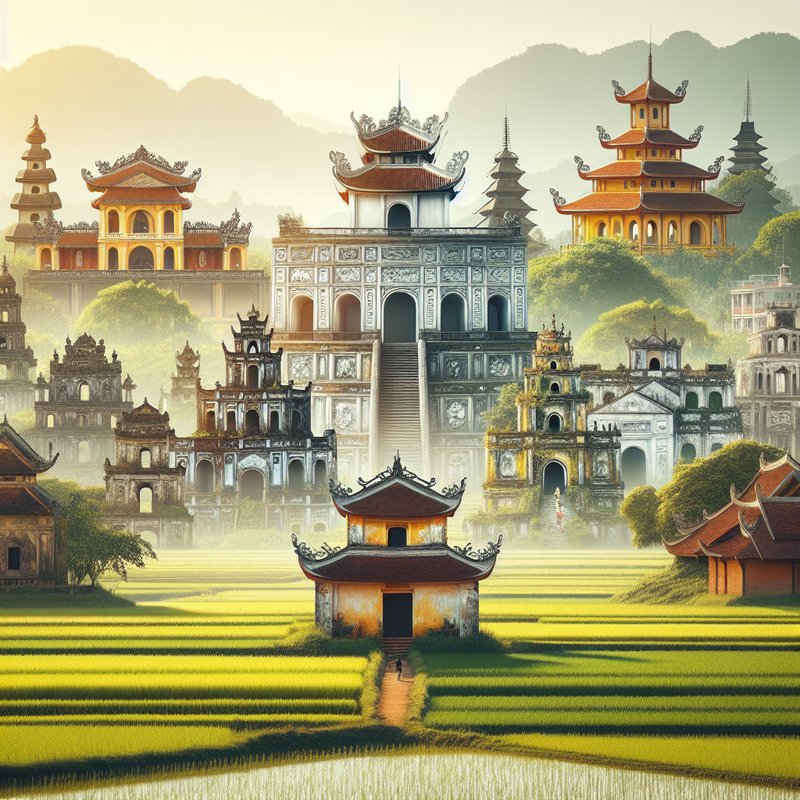The Ancient Capital of Hoa Lu

Discover the fascinating history of Hoa Lu, the ancient capital of Vietnam during the Dinh and early Le Dynasties, from 968 to 1010 AD. Nestled in Ninh Binh province, Hoa Lu served as the political, economic, and cultural hub of the nation during a formative period. The Dinh Dynasty, under the rule of Emperor Dinh Tien Hoang, established Hoa Lu as the capital, unifying the country after years of fragmentation. The subsequent Le Dynasty continued to develop Hoa Lu, leaving behind significant architectural and cultural relics. This era played a crucial role in shaping Vietnam into a centralized state, laying the foundation for future dynasties and the nation we know today. Exploring Hoa Lu offers a unique glimpse into the early political strategies, cultural developments, and historical events that were instrumental in the unification and establishment of Vietnam’s national identity.
Learn about the architectural remains, temples, and pagodas that offer insights into the cultural and religious practices of the time.
The Imperial City of Hue

Hue served as the capital of the Nguyen Dynasty and is renowned for its historic monuments, tombs, and the iconic Imperial City.
Hue, often referred to as Vietnam’s ancient imperial city, is a remarkable testament to the country’s rich history and its blend of cultural influences. The city’s architectural landscape is a vivid illustration of the fusion between traditional Vietnamese styles and French colonial architecture. This unique blend can be seen in various structures around Hue, such as the Imperial Citadel, which combines the grandeur of Vietnamese imperial design with subtle French touches.
Hue’s cultural significance is deeply rooted in its past as the capital of the Nguyen Dynasty. During this time, the city became a center of politics, culture, and religion in Vietnam. The preservation of historic monuments, tombs, and temples in Hue allows visitors to step back in time and gain a deeper understanding of Vietnam’s dynastic history and the cultural evolution that has shaped the nation. The architecture in Hue not only reflects the aesthetic values of different eras but also stands as a symbol of Vietnam’s resilience and ability to harmonize different cultural elements into a cohesive identity.
Thang Long – The Thousand-Year-Old Capital

The ancient city of Thang Long, known today as Hanoi, holds a wealth of history dating back over a thousand years.
The ancient citadel of Thang Long is a testament to Hanoi’s rich and diverse history. Established in the 11th century during the reign of the Ly Dynasty, the citadel has witnessed the rise and fall of several dynasties, each leaving its indelible mark on the architectural landscape. Visitors to the citadel can explore the remnants of royal palaces, grand halls, and ancient gates that once stood as symbols of power and prestige. The site is a UNESCO World Heritage Site, reflecting its global importance and the need for preservation.
In addition to the citadel, Hanoi is home to numerous historic temples that offer insights into the spiritual life of the city throughout history. The Temple of Literature, dedicated to Confucius, is one of the oldest and most significant temples in Vietnam. Founded in 1070, it served as the country’s first university and remains a symbol of Hanoi’s scholarly and cultural heritage. The One Pillar Pagoda, with its unique architectural design, is another iconic landmark that has stood the test of time since its construction in 1049.
Hanoi’s colonial architecture adds yet another layer to its historical tapestry. The influence of French colonial rule in the 19th and 20th centuries is evident in the city’s elegant boulevards, grand estates, and public buildings. The Hanoi Opera House, designed in the style of the Palais Garnier in Paris, and the St. Joseph’s Cathedral, with its neo-Gothic design, are prime examples of this architectural fusion. These structures not only showcase the city’s adaptability but also highlight the diverse influences that have shaped Hanoi into the vibrant capital it is today.
Modern Capital – Hanoi

While Hanoi is a bustling modern capital today, it still retains the charm and ambiance of its historic past. The city offers a unique blend of old and new, where centuries-old temples and pagodas stand alongside modern skyscrapers. Stroll through the Old Quarter, with its narrow streets and traditional shop houses, to experience the cultural vibrancy that has been preserved over generations. The timeless elegance of Hoan Kiem Lake and the ancient beauty of the Temple of Literature are just a few examples of how Hanoi seamlessly integrates its historical heritage with contemporary life. Despite rapid modernization, efforts continue to be made to protect and celebrate Hanoi’s rich history, making it a captivating destination for both locals and tourists.
Hanoi, Vietnam’s modern capital, has undergone significant transformations over the years, evolving from a historic city with deep cultural roots to a dynamic metropolis. Despite its modernization, Hanoi has made concerted efforts to preserve its rich cultural heritage and historic sites. The city’s Old Quarter, with its narrow streets and traditional shop houses, remains a vibrant hub that echoes the charm of a bygone era. Preservation projects, such as the restoration of ancient temples and pagodas, and the maintenance of colonial-era buildings, reflect Hanoi’s dedication to safeguarding its historical legacy. Additionally, museums and cultural centers have been established to educate both locals and visitors about the city’s storied past. These efforts ensure that while Hanoi continues to grow and modernize, the essence of its history and culture remains intact, offering a unique blend of the old and the new.

Leave a Reply